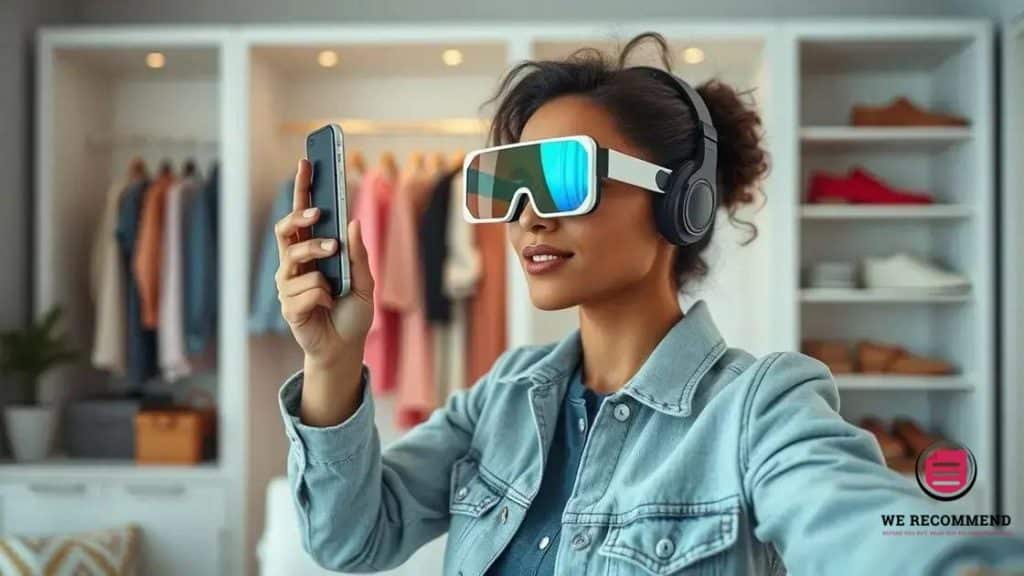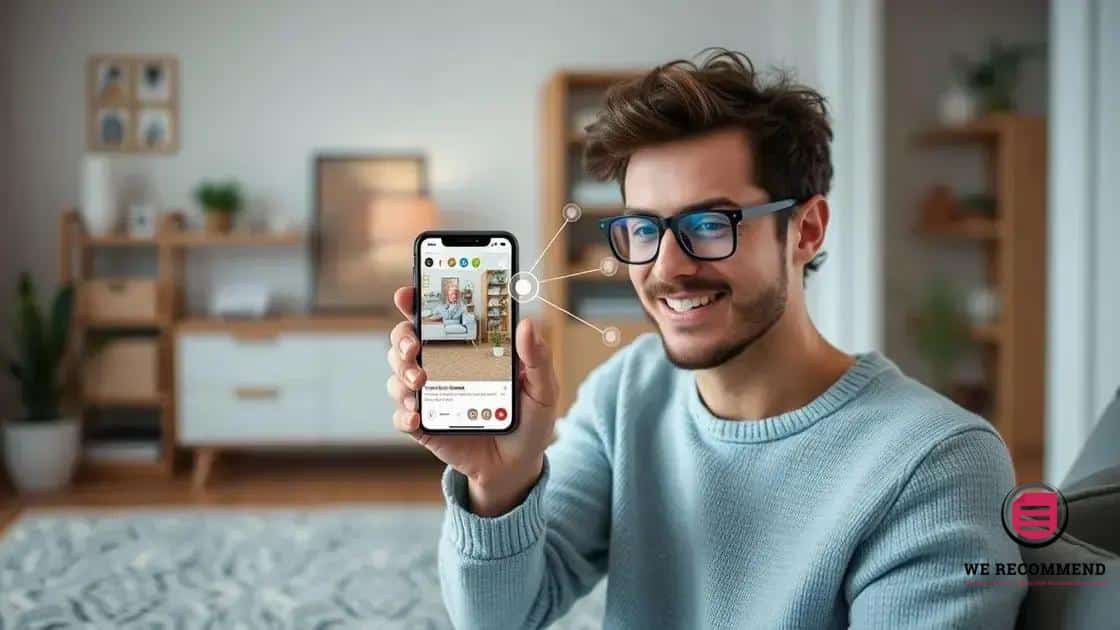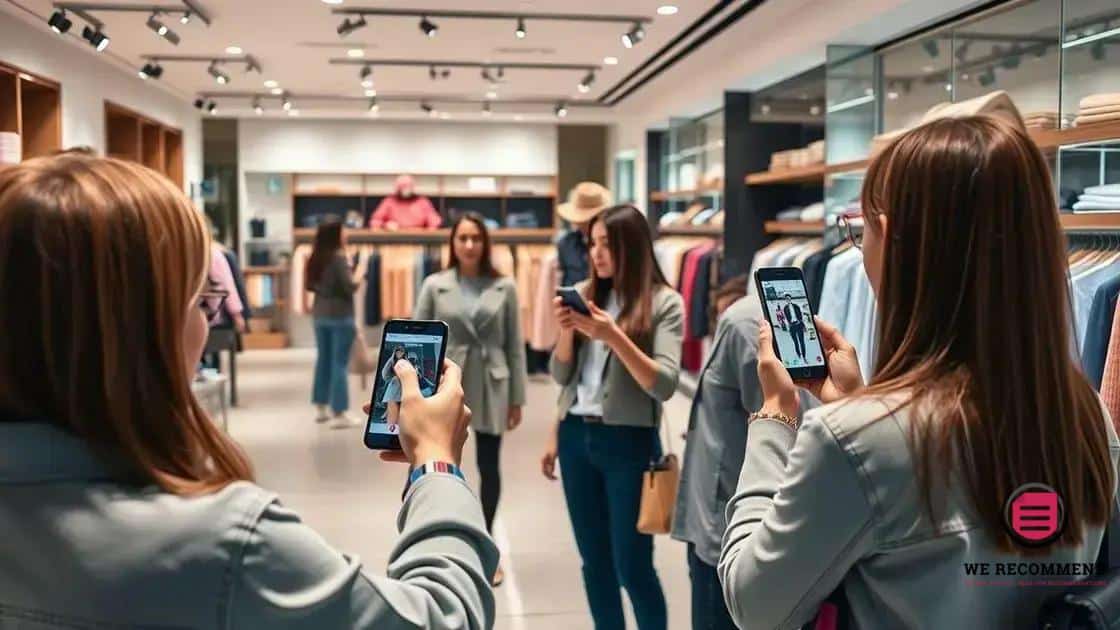AR shopping experiences online: Transform your retail

Anúncios
AR shopping experiences online utilize augmented reality to enhance the retail process, allowing consumers to visualize products in their environment, resulting in increased engagement and customer satisfaction.
AR shopping experiences online are reshaping retail landscapes by offering consumers immersive shopping opportunities. Have you ever wished you could try on clothes or see how furniture fits in your space without leaving home? This article uncovers the transformative power of AR technologies in e-commerce.
Anúncios
What are AR shopping experiences?
AR shopping experiences are a new way for consumers to engage with products. They combine physical and virtual worlds, allowing shoppers to see how items look in their real environment.
Anúncios
With this technology, you can try on clothes, visualize furniture in your home, or even test out makeup using your smartphone or AR glasses.
How AR Enhances Shopping
AR improves the shopping experience by making it more interactive. It helps in:
- Visualizing how products fit into your life.
- Providing detailed information about items.
- Reducing the uncertainty often felt when shopping online.
For more information about AR shopping, visit Forbes.
Benefits of AR in online shopping
The benefits of AR in online shopping are transforming the retail landscape. Shoppers can engage with products in a new way, leading to a more satisfying experience.
One major advantage is the ability to visualize products in your own space. Customers can see how furniture or decor looks in their homes before making a purchase.
Improved Decision Making
AR empowers consumers to make informed choices. It reduces doubts and helps eliminate the fear of buying the wrong item. Some key benefits include:
- Increased confidence in purchasing decisions.
- Fewer product returns due to better visualization.
- Enhanced customer satisfaction and loyalty.
To understand more about these benefits, you can check out this link: Retail Dive.
How to implement AR in your e-commerce
Implementing AR in your e-commerce store can greatly enhance customer experience. By providing immersive shopping opportunities, you can engage customers more effectively.
To get started, consider these practical steps:
Steps to Implement AR
First, choose the right AR platform that matches your needs and budget. Then, integrate it into your website or app. Key steps include:
- Selecting AR tools and software that are user-friendly.
- Creating high-quality 3D models of your products.
- Testing the AR features for usability and performance.
Once integrated, promote your new AR feature via marketing channels. For further insights, explore this resource from Shopify on using AR in e-commerce.
User experience in AR shopping

User experience in AR shopping plays a crucial role in how customers interact with products. A good AR experience can make shopping more engaging and enjoyable.
AR applications allow users to visualize products in their own environment, enhancing the way they shop online.
Key Aspects of User Experience
When designing AR shopping experiences, focus on these essential aspects:
- Ease of Use: Users should find the AR interface intuitive and easy to navigate.
- Realism: The more realistic the AR visuals, the better the customer experience.
- Interactivity: Engaging features that allow interaction increase user satisfaction.
A well-designed AR shopping experience can lead to higher engagement and lower return rates. For more insights, check out this article on Digital Commerce 360.
Challenges of AR shopping technology
While AR shopping technology offers significant benefits, it also presents several challenges that businesses must navigate. Understanding these obstacles is crucial for effective implementation.
One challenge is the cost of development. Creating high-quality AR experiences can require substantial investment in technology and skilled personnel.
Common Challenges Faced
Other challenges include:
- Technical Limitations: Not all devices support AR features, which can limit your customer base.
- User Experience Issues: If the AR experience is not intuitive, it may frustrate customers instead of enhancing their experience.
- Content Creation: Developing engaging AR content can be time-consuming and requires expertise.
For more information on AR challenges, you can refer to this detailed guide from Forbes.
Future trends in AR shopping
The future of AR shopping holds exciting possibilities that can further change how consumers interact with products. As technology advances, we can expect new trends to emerge.
One major trend is the integration of artificial intelligence with AR, creating personalized shopping experiences based on customer behavior.
Emerging Trends to Watch
Some key trends include:
- Enhanced Personalization: AR will start to offer tailored product recommendations, improving user experience.
- Seamless Online and Offline Integration: Businesses will blend AR tools into physical stores, allowing customers to experience products before buying.
- Advancements in Hardware: New devices, like AR glasses, will make the shopping experience more immersive and accessible.
To learn more about upcoming trends in AR, visit the insights from The Verge.
Case studies of successful AR applications
Case studies of successful AR applications illustrate how businesses can leverage this technology to enhance customer engagement and drive sales. Many brands have implemented AR in innovative ways, resulting in impressive outcomes.
For example, the furniture retailer IKEA launched an AR app called IKEA Place. This app allows customers to visualize furniture in their homes before purchasing.
Notable Examples
Here are a few case studies showcasing successful AR applications:
- Sephora: The beauty brand uses AR to let customers try on makeup virtually. This has improved customer satisfaction and increased online sales.
- L’Oreal: This company has implemented AR technology in its mobile app, enabling users to see how different hair colors look on them.
- Warby Parker: The eyewear retailer uses AR to allow customers to try on glasses virtually, reducing return rates and increasing conversions.
For more insights on successful AR case studies, check out Shopify.
Tips for retailers to enhance AR engagement

Retailers can significantly boost customer interaction through enhanced AR engagement. Integrating AR into shopping experiences can lead to higher satisfaction and increased sales.
To create engaging AR experiences, retailers should focus on several effective strategies.
Tips to Enhance AR Engagement
Consider these key tips to enhance the effectiveness of AR tools:
- Understand Your Audience: Know what your customers want and tailor AR features to meet their needs.
- Focus on User Experience: Ensure the AR application is user-friendly, simple to navigate, and visually appealing.
- Utilize Social Sharing: Incorporate features that allow customers to share their AR experiences on social media.
For more strategies and insights, check out this article from Forbes.
The Future of AR in Retail
Augmented Reality (AR) is changing the way we shop. It provides unique experiences that engage customers and enhance their buying journey.
As businesses adopt AR tools, they can bridge the gap between online and offline shopping, making it easier for customers to visualize products in their environment.
With the right strategies, retailers can improve customer satisfaction, boost sales, and stand out in a competitive market. Embracing AR technology is not just an option; it is becoming essential for retail success.
As we move forward, the innovation and growth in AR applications will pave the way for an exciting shopping experience.
FAQ – Frequently Asked Questions about AR in Retail
What is augmented reality (AR) in retail?
Augmented reality (AR) in retail enhances the shopping experience by allowing customers to visualize products in their own environment through digital overlays on their devices.
How can AR improve customer engagement?
AR improves customer engagement by providing interactive experiences, allowing shoppers to try products virtually, which increases their confidence in purchasing.
What are the costs associated with implementing AR technology?
Costs can vary depending on the complexity of the AR application, the technology used, and content creation. It’s essential to plan a budget that includes development and maintenance.
What are some successful examples of AR in retail?
Examples include IKEA’s AR app for visualizing furniture at home, Sephora’s virtual makeup try-on, and Warby Parker’s virtual eyewear fitting.






